
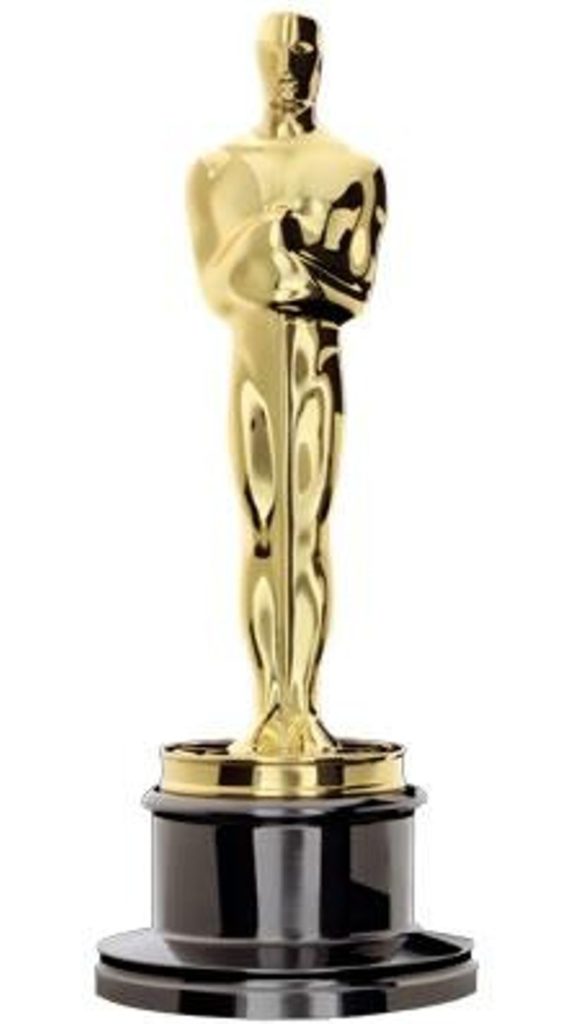
Academy Award trophy, dubbed “Oscar”
Outside of my life as a curator, I work with several film festivals as a film programmer. I select films from hundreds of submissions and have selected short films (“shorts”) for the Cinequest Film Festival since 2001. Cinequest is an Academy-qualifying festival, so if your film wins Best Animated Short Film at Cinequest, you’re eligible to be nominated for an Oscar. Thus, I am heavily invested in the Oscars every year, and most deeply involved with the Oscar for Best Animated Short Film. Having seen every Oscar nominee in the category since 1980, and nearly two-thirds of all the rest, I can say that no other category gives you a better view of film’s evolution.
Animation predates film, having evolved out of flip-books and toys such as the zoetrope, which appeared to make static images move. Filmed animation starts with an image, and then another image that is slightly different is added after it, and one that is slightly different still after that, and on and on. When these images are shown rapidly, one after another, your eye holds each image for a split second, and your brain creates the illusion that the figures in it are moving. Images can be drawings, paintings, photographs, or even everyday objects. They can be drawn on paper or painted on a clear medium such as celluloid or glass, which allows images to be stacked and photographed, giving the illusion of depth. Clay, wire armature dolls, and even sand have been used to create award-winning animations. The wide array of techniques available for animators to experiment with has lead to new methods that often find acceptance by live-action directors and cinematographers. From the early decades of the 20th century, beginning with the work of animators like Windsor McCay and J. Stuart Blackton, to the innovative works of the last 20 years, you can trace the path of cinematic production technologies back to their roots in animation.
Short films are another area where new techniques are first deployed. In fact, the first films were shorts made by inventors such as the Lumière brothers, Georges Méliès , and Edwin Porter. The fundamental techniques of filmmaking were created through experimentation in short form and, up through the 1950s, were an important part of the cinematic landscape. The rise of television and the death of the “Double Feature” led to a declining interest in short films, which for decades were mostly visible only at film festivals or other private screenings. This change in status actually allowed shorts to become more experimental. Often it is through short films that new talent comes to the attention of Hollywood, and with new talent comes new creative directions.
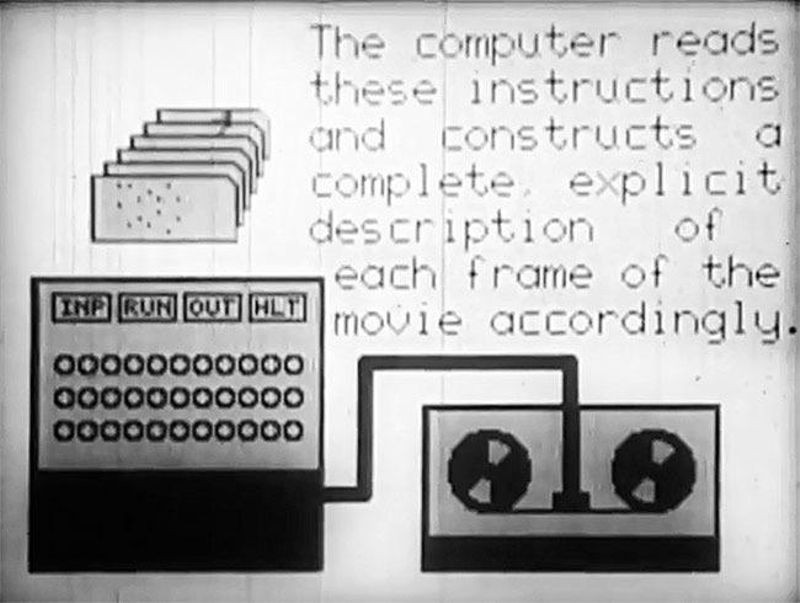
Still from “A Computer Technique” for the Production of Animated Movies, an early example of Bell Labs’ BEFLIX animation program
The introduction of the computer to film production began during the 1960s with work done at universities like Yale, MIT, and the University of Utah, as well as research groups such as Bell Labs. At many universities, especially Utah, funding from the Advanced Research Projects Agency (ARPA) fostered research in computer graphics, originally with an eye toward their defense applications. Bell Labs also served as a hothouse for innovation, drawing on the financial support of the Bell Telephone System.
Mainstream filmmakers would slowly begin to recognize the power of the computer starting in the early 1970s. Feature films like Westworld and its sequel, Futureworld, showed that computer graphics could add dramatic and visually arresting elements to film. Those two films each broke ground for Hollywood: Westworld introduced wireframe animation to a Hollywood film and Futureworld used Pixar co-founder Ed Catmulls “Computer-Animated Hand” as one of the earliest uses of 3-D computer graphics in a feature film. At the same time, animators working on smaller projects were beginning to explore the use of computers in creating short films.

Ed Catmull’s “A Computer-Animated Hand,” as featured in Richard Heffron’s Futureworld
Shorts have always been an arena for filmmakers to try new techniques, often created as demonstration pieces to show off new camera techniques or editing methods. Groups like the National Film Board of Canada encouraged filmmakers to use computers. One of the earliest such filmmakers was Peter Foldes, whose 1974 short La Faim (Hunger) was the first computer-animated film nominated for Best Animated Short Film. Foldes worked with National Research Council scientist Nestor Burtnyk to produce the film using Burtnyk’s “key frame animation” package. Traditionally, with key frame animation, an animator creates images that define a particular cartoon segment. These defining images, or “key frames,” are then used by a team of animators as the basis for completing the sequence. This way, a single animator can be free to work on the overall style and experience of an animation without having to personally draw each frame. Burtnyk’s program required the hand-drawn images to be scanned into the computer where the in-between images were created and added to give the illusion of movement. The resulting film had a very unusual flow, like nothing that had been seen in animation up to that point. (The technique is very similar to those used by artist Charles Csuri in his 10-minute short Hummingbird from 1966.) Hunger became a major hit on the film festival circuit, winning awards around the world, including the Prix du Jury at Cannes and an Academy Award nomination.
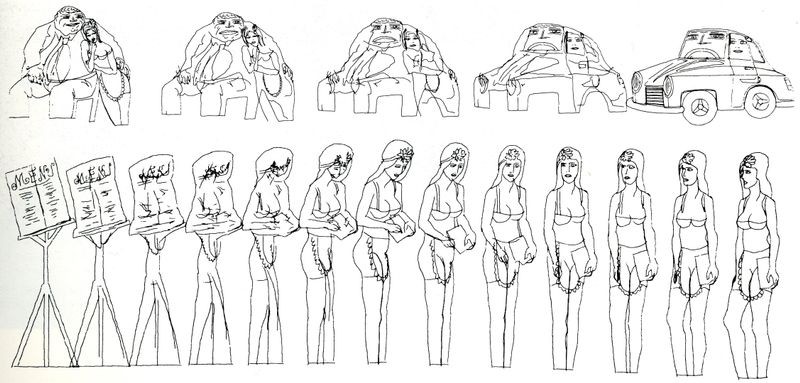
Examples of the “key frames” of Peter Foldes’ La Faim (Hunger)
The next year, in 1975, the first film containing computer animation won the award. Great is an animated short about the legendary engineer Isambard Kingdom Brunel, and while not completely computer animated, did include a wire-frame animation sequence showing the SS Great Eastern, much like the ones used in Westworld and two years later for the Death Star–planning in Star Wars. The segment was created by Stan Hayward of The Computer Studio at Imperial College, London using a system originally designed for architectural firms. The use of a cutting-edge drafting computer for the sequence mirrored the great innovator Brunel’s story—he used many state-of-the-art drafting techniques.

The wireframe animation of the Great Eastern, created by Stan Hayward for the Oscar-winning short film Great
Following Great, there was a long drought of computer-animation among nominees. Traditional animation forms, especially those using stop-motion clay models or paint-on-glass techniques dominated the nominees of the late 1980s. While one or two films nominated from 1976 to 1985 may have had a computer element or two (and computer-generated titles became popular during the early 1980s), it wasn’t until 1986 that another wholly computer-animated film was nominated. Pixar’s Luxo Jr. is one of the most iconic of all computer animation shorts. It provided the very identity of Pixar’s branding, the adorable little hopping lamp. This was the first Oscars I can remember studying all the nominees and thinking that Luxo Jr. was the one to beat. The eventual winner, however, was Van Tulden & Thijsen’s A Greek Tragedy, which was my favorite, with its delightfully comic traditional animation style.
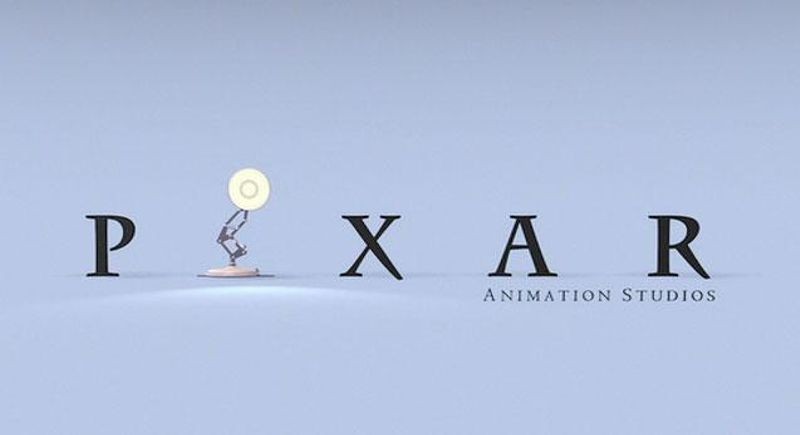
Luxo Jr. and the Pixar logo
Two years later came the breakthrough—Tin Toy. Pixar’s first Oscar-winning film, Tin Toy, followed the exploits of a wind-up, one-man band in a baby’s world. Tin Toy was officially a test for Pixar’s RenderMan animation software and the only film ever created by Pixar using the custom-built RM-1 computer system. It’s a far cry from Toy Story, released in 1995, but it had many of the elements of what Pixar would spend the next two decades producing: stories where everyday objects become extraordinary and imaginary worlds are believed to be real, a theme not only found in the Toy Story films, but also in their later films like Monsters Inc. and Cars. Tin Toy did not have the lasting impact of Luxo Jr., though it does stand as one of the most important milestones in both Pixar and Oscar history.
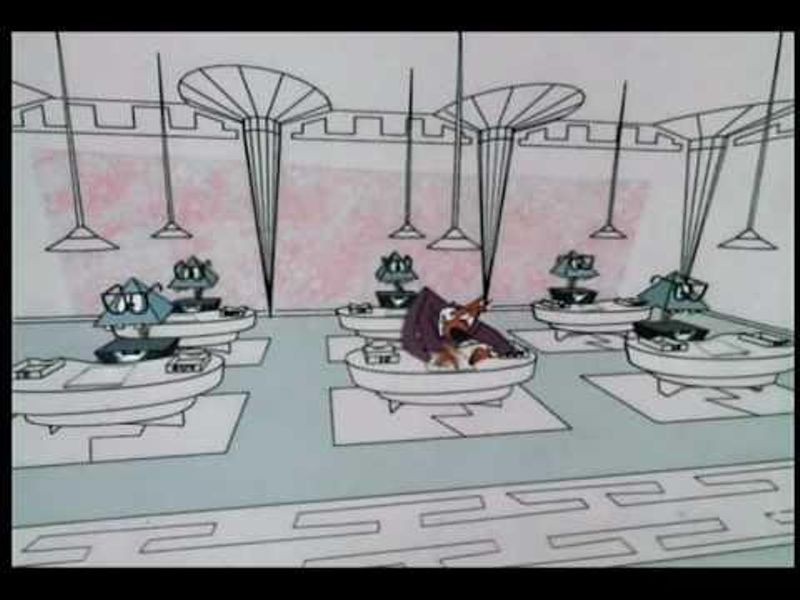
Still from Technological Threat featuring both traditional hand-drawn and computer-animated characters
That same year, another ground-breaking short was nominated. Technological Threat by Brian Jennings and Bill Kroyers is a combination of traditional, hand-drawn animation and computer animation. Kroyers and his wife, Sue, developed a software package to create the backgrounds and some of the characters. These could then be printed by a high-speed plotter, which the artists could then use for their animations. The story may be a fair representation of the lack of computer-animated films being nominated in the late 1970s and early 1980s when the number of computer animation projects on the festival circuit saw phenomenal growth. The story is of a number of dog animators (all hand-drawn) that are systematically replaced by robots (which were computer animated). The message is clear; humans are going to be replaced by computers in animation. The dogs fight back as more and more of them are replaced by the robots, using traditional cartoon violence attacks. More than any other cartoon of that period, Technological Threat may represent the best of what was possible combining computer animation with traditional animation techniques. The film was a massive hit at festivals like Spike & Mike’s Festival of Animation and on MTV’s Liquid Television. Perhaps the lack of Oscar recognition stemmed from Academy voters feeling a bit like our dog animators.
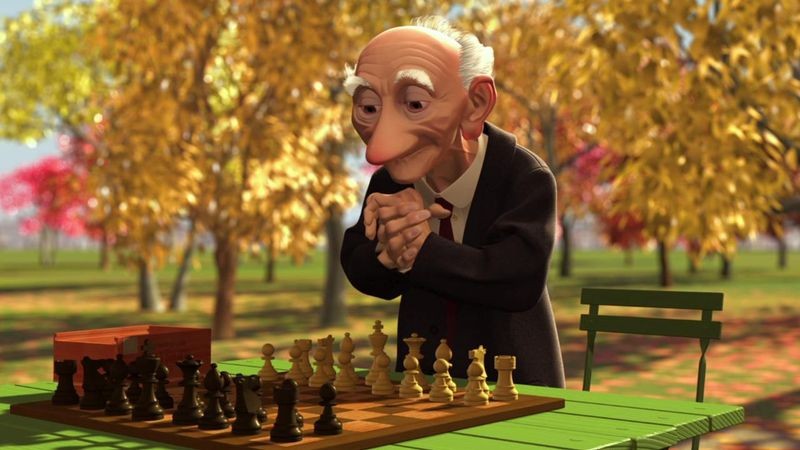
A still from Pixar’s Oscar-winning short film Geri’s Game
Despite an explosion in computer animation happening at the end of the 1980s, another fully computer animated film would not win Best Animated Short until 1997, two years after Toy Story became the first computer animated feature film. Geri’s Game, also from Pixar, broke a string of victories for stop-motion/claymation films winning the Oscar for producers like Aardman Animations of Wallace & Grommit fame. Pixar had been producing shorts as well as developing their feature films, often releasing short films to accompany their features in theaters. This gave short films their biggest stage since the decline of the double feature and day out at the movies. During that gap between computer-animated winners, only two computer animated films were even nominated, La Salla from Richard Condie and The End by Chris Landreth.
Perhaps the biggest change during this period was something outside of Hollywood. An explosion in off-the-shelf animation programs from the 1980s and 1990s brought packages such as PowerAnimator from Alias Research, Personal Visualizer from Wavefront Software, and PRISMS from Side Effects Software—powerful graphics and animation tools that allowed for easier integration of computer-generated material into non-computer generated footage. It was during this period of commercial graphics software growth that we began to see computer animation pop up on television, including a famous segment on The Simpsons where Homer enters a 3-D world, as well as on series such as Babylon 5. This melding of traditional techniques with computers mirrors what we had seen in music during the late 1970s and early 1980s with the explosion of synthpop. Many, if not most, animations by the late ’90s saw the use of computers for some portion of the film, be it background images, in-between animation, or sound design. In fact, much of the cell animation done in the 1990s are better seen as “computer-assisted.” A larger and larger percentage of films were released with significant computer-generated content, though not fully computer-animated, thus making it difficult to understand what would qualify as a “Computer Animated” short. As has often happened in film, and in the arts in general, the avant garde often becomes the mainstream.
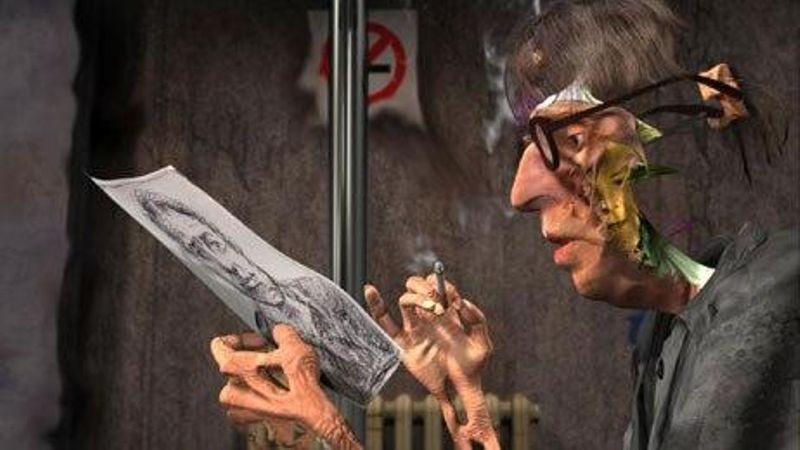
Chris Landreth’s animated documentary Ryan.
That’s not to say that some of the winners in the category certainly aren’t stunning and important moments in the history of graphics in animated film. Chris Landreth’s Ryan was the winning short in 2004. Ryan was an animated documentary based on an interview with famed Canadian avant garde animator Ryan Larkin and was an early example of the use of the program Maya. The following year featured The Mysterious Geographic Expeditions of Jasper Morello, a steampunk-inspired film, used many techniques, including Photoshop and the compositing program Combustion, along with photographed found objects and cut-out paper silhouettes, to tell a dark and moody horror story. Moonbot Studios’ The Fantastic Flying Books of Mr. Morris Lessmore was another short that combined model work, miniatures, computer animation, and tradition hand-drawn work. The result is an incredibly lyrical short telling a story that even the silent comedians of the 1920s would have adored. (I’m proud to say that I was on the teams that programmed all three of those shorts for Cinequest, where all of them won awards before going on to take home Oscar glory!)
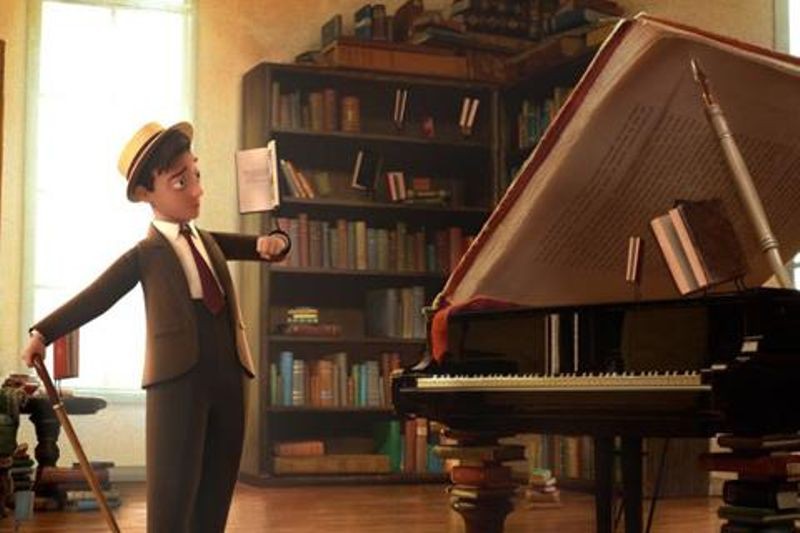
The Fantastic Flying Books of Mr. Morris Lessmore combined both traditional and computer animation techniques.
Today, a majority of the films nominated are computer animated. In fact, it’s become rare for a non-computer animated film to appear on the nomination list. So thoroughly has the computer infiltrated the world of animation, even films considered “traditional” animation often use computers in their production for titling and technical background tasks such as color and sound correction.